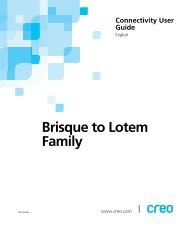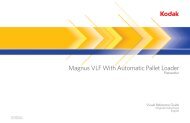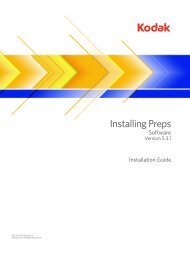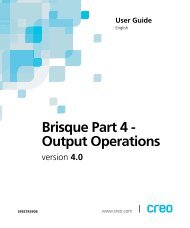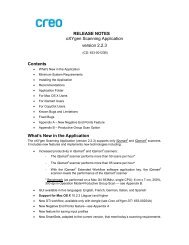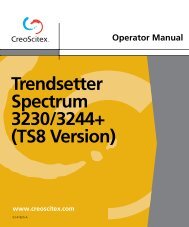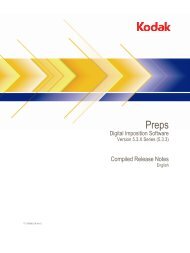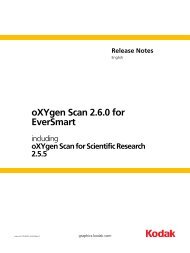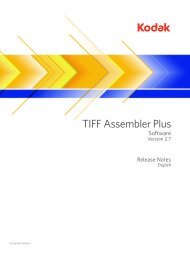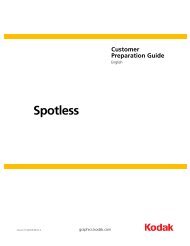Prinergy Evo and Kodak Proofing Software
Prinergy Evo and Kodak Proofing Software
Prinergy Evo and Kodak Proofing Software
- No tags were found...
You also want an ePaper? Increase the reach of your titles
YUMPU automatically turns print PDFs into web optimized ePapers that Google loves.
CopyrightTrademarks© <strong>Kodak</strong>, 2009. All rights reserved.Some documentation is distributed in Portable Document Format (PDF). You may reproduce such documentation fromthe PDF file for internal use. Copies produced from the PDF file must be reproduced in whole.<strong>Kodak</strong>, Creo, Approval, Brisque, eCentral, <strong>Kodak</strong> Veris, Matchprint, <strong>Prinergy</strong>, <strong>and</strong> <strong>Prinergy</strong> <strong>Evo</strong> are trademarks of <strong>Kodak</strong>.FCC complianceAcrobat, Adobe, Distiller, Illustrator, Photoshop, <strong>and</strong> PostScript are trademarks of Adobe Systems Incorporated.Apple, AppleShare, AppleTalk, iMac, ImageWriter, LaserWriter, Mac OS, Power Macintosh, <strong>and</strong> TrueType are registeredtrademarks of Apple Inc. Macintosh is a trademark of Apple Inc., registered in the U.S.A. <strong>and</strong> other countries.Hexachrome, PANTONE, PANTONE Goe, PANTONE Hexachrome, <strong>and</strong> PANTONE MATCHING SYSTEM are the propertyof Pantone, Inc.PEARL, PEARLdry, PEARLgold, PEARLhdp, <strong>and</strong> PEARLsetter are registered trademarks of Presstek, Inc.XEROX is a trademark of XEROX CORPORATION.Any <strong>Kodak</strong> equipment referred to in this document complies with the requirements in part 15 of the FCC Rules for a ClassA digital device. Operation of the <strong>Kodak</strong> equipment in a residential area may cause unacceptable interference to radio<strong>and</strong> TV reception, requiring the operator to take whatever steps are necessary to correct the interference.Equipment recyclingIn the European Union, this symbol indicates that when the last user wishes to discard thisproduct, it must be sent to appropriate facilities for recovery <strong>and</strong> recycling.Contact your local <strong>Kodak</strong> representative or refer to http://www.kodak.com/go/recycle/ for additionalinformation on the collection <strong>and</strong> recovery programs available for this product.REACHPlease consult http://www.kodak.com/go/REACH for information about the presence of substances included on thec<strong>and</strong>idate list according to article 59(1) of Regulation (EC) No. 1907/2006 (REACH).Limitation of liabilityThe product, software or services are being provided on an “as is” <strong>and</strong> “as available” basis. Except as may be statedspecifically in your contract, <strong>Kodak</strong> expressly disclaims all warranties of any kind, whether express or implied, including,but not limited to, any implied warranties of merchantability, fitness for a particular purpose <strong>and</strong> non-infringement.You underst<strong>and</strong> <strong>and</strong> agree that, except as may be stated specifically in your contract, <strong>Kodak</strong> shall not be liable for anydirect, indirect, incidental, special, consequential or exemplary damages, including but not limited to, damages for loss ofprofits, goodwill, use, data or other intangible losses (even if <strong>Kodak</strong> has been advised of the possibility of such damages),resulting from: (i) the use or the inability to use the product or software; (ii) the cost of procurement of substitute goods<strong>and</strong> services resulting from any products, goods, data, software, information or services purchased; (iii) unauthorizedaccess to or alteration of your products, software or data; (iv) statements or conduct of any third party; (v) any othermatter relating to the product, software, or services.The text <strong>and</strong> drawings herein are for illustration <strong>and</strong> reference only. The specifications on which they are based aresubject to change. <strong>Kodak</strong> may, at any time <strong>and</strong> without notice, make changes to this document. <strong>Kodak</strong> assumes noliability for technical or editorial errors or omissions made herein, <strong>and</strong> shall not be liable for incidental, consequential,indirect, or special damages, including, without limitation, loss of use, loss or alteration of data, delays, or lost profits orsavings arising from the use of this document.http://graphics.kodak.com/Internal 734-00085B-EN-N-PR01
Revised 2009-09-01
Contents1 Introduction..........................................................................................................................................1Prerequisites....................................................................................................................................................................................12 Setting up <strong>Kodak</strong> <strong>Proofing</strong> <strong>Software</strong>..............................................................................................3Enabling unlicensed demo mode...............................................................................................................................................3Downloading configuration files from eCentral ....................................................................................................................3Installing configuration files.......................................................................................................................................................4Calibrating the proofer.................................................................................................................................................................4Enabling <strong>and</strong> disabling Precision Color calibration......................................................................................................4Creating a calibration...........................................................................................................................................................5Creating a custom layout ...........................................................................................................................................................6Exporting ICC profiles..................................................................................................................................................................63 Setting up <strong>Prinergy</strong> <strong>Evo</strong>.....................................................................................................................7Downloading <strong>and</strong> importing PANTONE color library files..................................................................................................7PANTONE color libraries....................................................................................................................................................7Importing color library files................................................................................................................................................7Adding proofers to <strong>Prinergy</strong> <strong>Evo</strong> Administrator....................................................................................................................84 Setting up process templates without ColorFlow......................................................................9Copying ICC profiles to the <strong>Prinergy</strong> <strong>Evo</strong> server....................................................................................................................9Selecting a RIP................................................................................................................................................................................9RIP choice...............................................................................................................................................................................9Selecting a RIP in <strong>Prinergy</strong> <strong>Evo</strong>........................................................................................................................................10Selecting a RIP in Open Connectivity Kit......................................................................................................................10Editing a refine to PDF template..............................................................................................................................................10Editing output from PDF templates.........................................................................................................................................115 Setting up ColorFlow........................................................................................................................15Setting up ColorFlow software for imported signed profiles............................................................................................15Creating a color setup........................................................................................................................................................15Creating a ColorFlow device............................................................................................................................................16Defining a device condition..............................................................................................................................................16Using a custom reference device condition.................................................................................................................17Creating an SCO..................................................................................................................................................................18Importing a device profile.................................................................................................................................................18Importing a DeviceLink......................................................................................................................................................19Taking a snapshot...............................................................................................................................................................19Approving a snapshot.......................................................................................................................................................206 Setting up process templates with ColorFlow...........................................................................21Editing output from PDF templates.........................................................................................................................................21
vi<strong>Prinergy</strong> <strong>Evo</strong> <strong>and</strong> <strong>Kodak</strong> <strong>Proofing</strong> <strong>Software</strong> Direct Connectivity Configuration User Guide7 Certified Process for Color Confirmation..................................................................................25<strong>Prinergy</strong> <strong>Evo</strong> settings that work with Certified Process for Color Confirmation.........................................................25More about profile names........................................................................................................................................................258 Improved output for multiple Matchprint Inkjet proofers.....................................................29Introduction..................................................................................................................................................................................29Appropriate number of JTPs solution....................................................................................................................................29Render resolution solution........................................................................................................................................................29Render resolution...............................................................................................................................................................29Setting the render resolution..........................................................................................................................................30Load balance solution................................................................................................................................................................30Load balance.......................................................................................................................................................................30Setting up the load balance workaround.......................................................................................................................31Using the load balance workaround...............................................................................................................................31
1IntroductionPrerequisitesThis user guide describes how to set up the direct connectivityconfiguration of <strong>Kodak</strong> ® <strong>Prinergy</strong> ® <strong>Evo</strong> software <strong>and</strong> <strong>Kodak</strong> <strong>Proofing</strong><strong>Software</strong> to output proofing jobs to a <strong>Kodak</strong> Matchprint ® Inkjet proofer.It also describes a setup with <strong>and</strong> without <strong>Kodak</strong> ColorFlow software.●●●●●●<strong>Prinergy</strong> <strong>Evo</strong> 5.1.6.0 or later (This document reflects <strong>Prinergy</strong> <strong>Evo</strong>5.1.6.0.)<strong>Prinergy</strong> <strong>Evo</strong> software must have the following modules licensed,installed, <strong>and</strong> running:❐ Proof Color Management (part number 632-00164A)❐ <strong>Prinergy</strong> <strong>Evo</strong> <strong>Proofing</strong> Connectivity Kit (part number 632-00167A)This document reflects <strong>Prinergy</strong> <strong>Evo</strong> 4.1.6.0.Basic operating knowledge of the <strong>Prinergy</strong> <strong>Evo</strong> software, particularlyhow to create a new process template. For information aboutworking with <strong>Prinergy</strong> <strong>Evo</strong>, see the <strong>Prinergy</strong> <strong>Evo</strong> User Guide.<strong>Kodak</strong> <strong>Proofing</strong> <strong>Software</strong> 4.0.0 or later (This document reflects<strong>Kodak</strong> <strong>Proofing</strong> <strong>Software</strong> 4.0.0.)Matchprint Inkjet proofer installed <strong>and</strong> configured with a customsheet layout (if you are not using a default layout)ColorFlow software version 1.0.6.0 or later (This document reflectsColorFlow 1.0.6.0.)
2 Chapter 1—Introduction
2Setting up <strong>Kodak</strong><strong>Proofing</strong> <strong>Software</strong>Enabling unlicensed demo modeThis procedure is optional. Demo mode is available for <strong>Kodak</strong> <strong>Proofing</strong><strong>Software</strong> only when the software is unlicensed <strong>and</strong> lacks a dongle.When <strong>Kodak</strong> <strong>Proofing</strong> <strong>Software</strong> is in demo mode, you can add asupported proofer (if you have one) or add simulated proofers (if youdon’t have a supported proofer), <strong>and</strong> use the <strong>Kodak</strong> <strong>Proofing</strong> <strong>Software</strong>features. However, proofs print with a watermark, <strong>and</strong> simulatedproofers only simulate printing, but do not print.After using demo mode, you can license <strong>Kodak</strong> <strong>Proofing</strong> <strong>Software</strong> <strong>and</strong>start using proofers for production work. Proofs will no longer print witha watermark. For more information, see the <strong>Kodak</strong> <strong>Proofing</strong> <strong>Software</strong> Help.1. In Proofer Administrator, click the Controller icon, <strong>and</strong> click theLicense tab.2. Select the Demo mode check box.3. Click the Proofers tab, <strong>and</strong> click Add.4. In the Add Proofers dialog box, select Add proofer to this controller,<strong>and</strong> then click Next.5. Follow the prompts in the Add Proofer Wizard.Note: If you do not have a supported proofer model, add a simulated proofer.Simulated proofer names end with (Simulated).6. After adding a proofer, the Proofer Controller might restart.Downloading configuration files from eCentralFor Matchprint Inkjet proofers, ICC profiles, ICC DeviceLink profiles, <strong>and</strong>media configurations are posted on <strong>Kodak</strong> eCentral ® . These downloadsare packaged into configuration files for each proofer model. Search,download, <strong>and</strong> install configuration files by proofer model.Note: To obtain media configuration files <strong>and</strong> other resources for <strong>Kodak</strong> Approval proofers, contact your service representative, or create media configuration filesusing the Approval Media Configuration Manager.1. Go to eCentral (https://ecentral.kodak.com/).2. At the top of the navigation bar, click Self Support <strong>and</strong> clickDownloads.3. In the Product list, select Matchprint Inkjet, <strong>and</strong> click Go.
4 Chapter 2—Setting up <strong>Kodak</strong> <strong>Proofing</strong> <strong>Software</strong>4. Click the proofer model <strong>and</strong> locate the configuration file for themedia you want to use. Ensure the media configuration file iscompatible with your version of <strong>Kodak</strong> <strong>Proofing</strong> <strong>Software</strong>.5. Click the configuration file to download it. If necessary, enter your<strong>Kodak</strong> user name <strong>and</strong> password.6. Save the file to your desktop.Installing configuration filesInstall configuration files in <strong>Kodak</strong> <strong>Proofing</strong> <strong>Software</strong> to add new files toyour system or update your system with the latest files.Do not manually unzip <strong>and</strong> install the package. You must use thefollowing procedure to install the package. Each time you add a newproofer to the system you must reinstall configuration files becausethey are excluded from the default settings.1. In Proofer Administrator, click the Controller icon, <strong>and</strong> click the<strong>Software</strong> tab.2. Click Install.3. Navigate to the installer software file, select it, click Open, <strong>and</strong> thenclick Install.When the installation is complete, the installer displays a message thatindicates the files installed successfully.Next:Calibrating the prooferIf you installed the configuration file to update the system, click Moreto display information about reconfiguring the system.Enabling <strong>and</strong> disabling Precision Color calibrationTwo calibration technologies are available: Precision Color technology<strong>and</strong> ColorZone technology. The Epson Stylus ® Pro 7900 printer <strong>and</strong>9900 printer can only use Precision Color calibration technology tocalibrate the proofer. All other inkjet proofers can use Precision Colortechnology or ColorZone technology to calibrate the proofer. Use theMedia Configuration Editor to enable <strong>and</strong> disable Precision Colortechnology for a media configuration.1. In Proofer Viewer, from the Configure menu, select MediaConfiguration.2. Select a media configuration, <strong>and</strong> click Edit.
Creating a calibration 53. Click the Calibration tab, <strong>and</strong> perform one of the following actions:ToUse Precision Color calibrationtechnologyUse ColorZone calibration technologyDo thisSelect the Use Precision ColorCalibration check box.Clear the Use Precision ColorCalibration check box.Creating a calibration4. Click Save.Note: Some media configurationscan only use Precision Colorcalibration. You cannot clear the UsePrecision Color Calibration check boxfor these media configurations.When you click the Calibrate button in the Calibration window inProofer Viewer, <strong>Kodak</strong> <strong>Proofing</strong> <strong>Software</strong> starts the appropriatewizard. When Precision Color technology is enabled for a mediaconfiguration, the Precision Color Calibration wizard starts. WhenPrecision Color technology is disabled for a media configuration, theColorZone Calibration wizard starts.For best results, calibrate the proofer for the media configuration. Youmust calibrate the proofer to be able to use the <strong>Kodak</strong> CertifiedProcess for Color Confirmation.Two calibration technologies are available: the existing ColorZonetechnology <strong>and</strong> the new Precision Color technology. When you create acalibration, the appropriate technology is used. All media configurationfiles created with ColorZone technology can be converted to PrecisionColor technology if desired. Use the Media Configuration Editor toenable Precision Color technology for a media configuration.1. In Proofer Viewer, click Calibration.2. Select a media configuration.3. Click Calibrate.4. Follow the instructions in the Calibration wizard.Note: If you are using a <strong>Kodak</strong> X-Rite ® i1 ® spectrophotometer, wait a fewseconds after clicking the measurement key before you draw the i1spectrophotometer across the control strip. A computer beep indicates whento begin the reading, but it may be too faint to hear in a print shop.
6 Chapter 2—Setting up <strong>Kodak</strong> <strong>Proofing</strong> <strong>Software</strong>Creating a custom layoutIf none of the built-in layouts suits your needs, create a custom layoutwith the Layout Editor.1. In the Proofer Viewer, from the Configure menu, select Layouts.2. Click New.3. Select the options as desired.4. Click Save.Exporting ICC profilesYou can export an ICC profile or ICC device link profile, <strong>and</strong> import itinto <strong>Kodak</strong> <strong>Proofing</strong> <strong>Software</strong> or copy it to workflow software, such as<strong>Prinergy</strong>.Alternately, you can export an ICC profile or ICC device link profile <strong>and</strong>its usage description to produce a resource file that you can importonly into <strong>Kodak</strong> <strong>Proofing</strong> <strong>Software</strong>.Note: Profiles provided by <strong>Kodak</strong> are signed.1. In Proofer Administrator, click the Proofer icon, <strong>and</strong> select the ICCProfiles tab.2. Select the ICC profile or device link profile that you want to export,<strong>and</strong> click Export.3. In the Export Profile dialog box, select how much information youwant to include with the profile, <strong>and</strong> click OK.4. Locate a folder <strong>and</strong> click Save.
8 Chapter 3—Setting up <strong>Prinergy</strong> <strong>Evo</strong>Adding proofers to <strong>Prinergy</strong> <strong>Evo</strong> AdministratorRequirements: <strong>Prinergy</strong> <strong>Evo</strong> 3.1.6.3 <strong>and</strong> later<strong>Prinergy</strong> <strong>Evo</strong> detects all of the Matchprint Inkjet proofers on thenetwork. Before you can use a proofer, add it in the Select Veris/Matchprint Inkjet Proofers dialog box. When you have successfullyadded a proofer, it appears in the output from PDF, output fromimposition, <strong>and</strong> output from Adobe ® PostScript ® process templates.1. In the <strong>Prinergy</strong> <strong>Evo</strong> Administrator, click the Tools tab.2. Click Veris/Matchprint Proofers or <strong>Kodak</strong> Proofers, depending onyour version of <strong>Prinergy</strong> <strong>Evo</strong>.3. In the Visible Veris/Matchprint Proofers or Visible <strong>Kodak</strong>Proofers list, select one or more proofers, <strong>and</strong> click the right-arrowbutton.The proofers move to the Veris/Matchprint Proofers to Use or<strong>Kodak</strong> Proofers to Use list. Different versions of <strong>Prinergy</strong> <strong>Evo</strong> usedifferent names for the lists.4. If the name of the proofer that you want does not appear in theVisible Veris/ Matchprint Proofers or Visible <strong>Kodak</strong> Proofers list,click Use <strong>and</strong> type the IP address or the name of the proofer thatyou want to add.Sometimes a proofer fails to appear when the proofer is in adifferent subnet than <strong>Prinergy</strong> <strong>Evo</strong> Administrator.Note: When manually adding the name of a proofer, ensure that you type its IPaddress <strong>and</strong>/or name correctly. Otherwise, the proofer will not correctlyappear in the Process Template Editor.5. Click OK.6. In the information window, click OK.7. On the System tab, click Restart.8. In the <strong>Prinergy</strong> <strong>Evo</strong> Shutdown - Restarting dialog box, select Finishcurrent processing before stopping <strong>Prinergy</strong> <strong>Evo</strong>, <strong>and</strong> click RestartNow.The restart process may take a few minutes. Warning messages willappear if the server needs to disconnect the <strong>Prinergy</strong> <strong>Evo</strong> Clientsoftware.
4Settingup processtemplates withoutColorFlowCopying ICC profiles to the <strong>Prinergy</strong> <strong>Evo</strong> serverSelecting a RIPRIP choiceRequirements:ICC profiles <strong>and</strong>/or DeviceLink ICC profiles have been exported fromProofer Administrator.If you are using <strong>Kodak</strong> <strong>Proofing</strong> <strong>Software</strong> 3.2.0 <strong>and</strong> later with <strong>Prinergy</strong><strong>Evo</strong> 3.2.6.1 <strong>and</strong> later, a <strong>Kodak</strong> service representative can set up the<strong>Prinergy</strong> <strong>Evo</strong> software to automatically copy all signed profiles from<strong>Kodak</strong> <strong>Proofing</strong> <strong>Software</strong>. With this option enabled, you no longer needto manually copy signed profiles between the two systems. However,you still need to copy unsigned profiles.1. On the <strong>Prinergy</strong> <strong>Evo</strong> server, create a folder in the ICC-Profilesfolder (for example, ICC-Profiles\Printer\)for the <strong>Kodak</strong> <strong>Proofing</strong> <strong>Software</strong> profiles. If the folder already exists,skip this step.Note: On <strong>Prinergy</strong> <strong>Evo</strong> servers, the ICC-Profiles folder is in thePgy<strong>Evo</strong>Config share.2. Copy the ICC profiles <strong>and</strong> DeviceLink profiles to the ICC-Profiles\Printer\ folder.3. On the <strong>Prinergy</strong> <strong>Evo</strong> server, share the folder that contains theprofiles, so you can access the folder from the <strong>Prinergy</strong> <strong>Evo</strong> Clientsoftware.4. If you are using custom ICC profiles, copy the custom profiles to the<strong>Prinergy</strong> <strong>Evo</strong> server computer.Note: When you create custom ICC profiles <strong>and</strong> want to use them with acertified process, submit the profiles to <strong>Kodak</strong> for signing before copying them.<strong>Prinergy</strong> <strong>Evo</strong> 4.x <strong>and</strong> later lets you choose whether to use Adobe CPSIRIP or Adobe PDF Print Engine RIP when you create an output from PD<strong>Kodak</strong> <strong>Proofing</strong> <strong>Software</strong> with Open Connectivity Kit 3.2.2 <strong>and</strong> later alsolets you choose between the two RIPs. Previous versions of <strong>Kodak</strong><strong>Proofing</strong> <strong>Software</strong> with Open Connectivity Kit included only the AdobeCPSI RIP. For best results, for your production jobs, use the same RIP in
10 Chapter 4—Setting up process templates without ColorFlowSelecting a RIP in <strong>Prinergy</strong> <strong>Evo</strong>your workflow software <strong>and</strong> in <strong>Kodak</strong> <strong>Proofing</strong> <strong>Software</strong> with OpenConnectivity Kit.Note: <strong>Kodak</strong> <strong>Proofing</strong> <strong>Software</strong> with Open Connectivity Kit is a licensed feature.1. In the Process Template Editor, open an output from PDF processtemplate.2. Exp<strong>and</strong> the Render section <strong>and</strong> select a RIP. For best results, useAdobe CPSI.3. Complete the other options as desired, <strong>and</strong> click Save.Selecting a RIP in Open Connectivity Kit1. In Proofer Viewer, from the Configure menu, click Hot Folders /Virtual Printers.2. Complete the options as desired, <strong>and</strong> click Next.3. On the Input Files tab, in the PDF RIP option area, select a RIP. Forbest results, use Adobe CPSI.4. Complete the remaining options on the tabs as desired, <strong>and</strong> clickSave.Editing a refine to PDF templateThis section assumes that input files contain spot colors <strong>and</strong> that thefiles will be printed as CMYK plus spot colors on press. For the best spotcolorinkjet-proofing results, leave the spot colors defined as spotcolors in the digital file, <strong>and</strong> color-manage the spot colors during proofoutput to allow the spot color recipe to take advantage of the gamut ofthe proofer. When a spot color is converted to a process color duringthe refine, it limits control of the color reproduction on the proof.1. In the Process Template Editor, open a refine process template.2. In the Generate box, select PDF.3. In the Normalize section, in the PDF 1.4 - 1.6 (Acrobat 5 - 7) list,select an option as desired.This option specifies how to h<strong>and</strong>le transparent objects.4. In the Spot Color H<strong>and</strong>ling section, set the following options:●●●●●Select Don’t Map Spot Colors.Select Autoresolve Spot Color Naming Conflicts, <strong>and</strong> in theResolve to list, select C.Select Resolve Ambiguous Spot Color Definitions.Select Look Up Recipe in Color Database.In the User Library list, select None.
Editing output from PDF templates 11● In the Factory list, select PANTONE CMYK 2000.● In the Convert to Destination Profile area, select a profile thatrepresents the final output color space, such asUSWebCoatedSWOP.icc. The final output color space is usuallythe press color space.Note: The profile that you select here automatically appears in the FinalOutput Process Profile box in the Match Colors section. These profiles arealways the same.5. In the Match Colors section, select Strip Embedded Profiles, <strong>and</strong>select profiles for CMYK Images, CMYK Graphics, RGB Images,<strong>and</strong> RGB Graphics.Note: When you select Strip Embedded Profiles but fail to select any profilesin the process template, <strong>Prinergy</strong> <strong>Evo</strong> strips any embedded profiles from theimages <strong>and</strong> graphics in the input files but does not replace them, because noreplacement profiles were identified in the process template.Note: The <strong>Prinergy</strong> <strong>Evo</strong> software does not support ICC profiles embedded inPostScript input files, because PostScript does not fully support embeddedprofiles.6. Set the remaining options as desired, <strong>and</strong> save the template.Editing output from PDF templatesThis procedure describes how to edit an output from the PDF processtemplate for inkjet proofing. For information about other <strong>Prinergy</strong> <strong>Evo</strong>features, see the <strong>Prinergy</strong> <strong>Evo</strong> User Guide.This procedure assumes that a job will be printed as CMYK plus spotcolors on press <strong>and</strong> describes how to best h<strong>and</strong>le spot colors. Thissection describes how to use color libraries <strong>and</strong> ICC profiles to simulatethe spot colors in digital files on inkjet proofs. Submitting files withCMYK plus spot colors to the proofer is key to the workflow settingsdescribed next <strong>and</strong> provides you with the best options for spot colorh<strong>and</strong>ling.In <strong>Kodak</strong> <strong>Proofing</strong> <strong>Software</strong>, ensure the following resources that youwant to use are enabled: media configuration files, layouts, ICC profiles,DeviceLink ICC profiles, <strong>and</strong> color bars.Note: For the Matchprint Inkjet 400 <strong>and</strong> 800 proofing solution with the HP ®Designjet ® printers, you can improve processing speeds by setting the renderresolution.1. In the Process Template Editor, open a default process template.2. In the Output To box, select <strong>Kodak</strong> Proofers (KPS direct connect).
12 Chapter 4—Setting up process templates without ColorFlow3. In the Device section of the process template, set the followingoptions:●●In the Proofer Name list, select the name of the proofer.In the Proofer Model list, select the name of the proofer model.Some versions of software automatically display the proofermodel in this box.4. In the Layout section, set the following options:●●●In the Media Configuration list, select the appropriate proofermedia.In the Proofer Layout or Layout for <strong>Kodak</strong> Proofers list, selectthe <strong>Kodak</strong> <strong>Proofing</strong> <strong>Software</strong> layout with Certified Process forColor Confirmation disabled.Note: If you use the Certified Process for Color Confirmation, select the<strong>Kodak</strong> <strong>Proofing</strong> <strong>Software</strong> layout with Certified Process for ColorConfirmation enabled.In the N-Up area, in the Number of Pages Across box <strong>and</strong> in theDown box, type 1.Note: This option is unavailable when you are setting up an output fromimposition process template.The Proofer Layout or Layout for <strong>Kodak</strong> Proofers list displays theenabled layouts in <strong>Kodak</strong> <strong>Proofing</strong> <strong>Software</strong>. The MediaConfiguration list displays the enabled media configurations in<strong>Kodak</strong> <strong>Proofing</strong> <strong>Software</strong>. For more information, see the <strong>Kodak</strong><strong>Proofing</strong> <strong>Software</strong> User Guide.If the imposition is smaller than a sheet’s imageable area, select a 1-Up layout. If the imposition is larger, select a Tiled layout. Forinformation about using layouts for doublesided media withMatchprint Inkjet proofers, see the <strong>Kodak</strong> <strong>Proofing</strong> <strong>Software</strong> UserGuide.If you are outputting imposition files (PJTF or JDF), the layout isdetermined in your imposition software (for example, the <strong>Kodak</strong>Preps ® digital imposition software or the <strong>Kodak</strong> P<strong>and</strong>ora ® step-<strong>and</strong>repeatsoftware), but it is limited to the proofer sheet size. That iswhy you must select a 1-up or tiled proofing layout for impositionfiles.5. In the Render section, set the following options:●●In the Resolution X <strong>and</strong> Resolution Y boxes, confirm that theresolution matches the resolution of the proofer that you aresending proofs to. If it does not, select a different mediaconfiguration in the Layout section.In the Spot Color H<strong>and</strong>ling list, select Convert to Process.I6. In the Match Colors section, set the following options:For descriptions of ICC profiles, which you’ll need for every proofingprocess, see the description in <strong>Prinergy</strong> or the description in the
Editing output from PDF templates 13Proofer Administrator, where all of the ICC profiles are listed <strong>and</strong>described.●For Profile, Select As defined below. Locate the ICC Profilesfolder, <strong>and</strong> select the source or DeviceLink profile that matchesthe color space you are simulating.Note: If you are using the Certified Process for Color Confirmation, ensurethat it is a signed profile. All default profiles are signed.●●●Note: When you select Refine Final Output Profile, <strong>Prinergy</strong> <strong>Evo</strong> uses thedestination profile (if there is one) from the refine process template as thesource profile.For Proof Profile, locate the ICC Profiles folder, <strong>and</strong> select aprofile that matches the device, media, resolution, <strong>and</strong> ink thatyou’re using.Note: If you are using the Certified Process for Color Confirmation, ensurethat it is a signed profile. All default profiles are signed.In the Rendering Intent list, select a rendering intent.In the Overprint H<strong>and</strong>ling (CPU Intensive) list, select Raster.Note: It is important to select this option to optimize the colormanagement of files. However, processing time will increase when theoption is selected.7. In the Spot Color H<strong>and</strong>ling section, set the following options:a. Select Lookup Recipe in Color Database to replace spot colorswith known reliable color recipes. If the software can’t find thoserecipes, it uses the recipes in the file.b. Select a color library. If the color libraries that you need areincluded in <strong>Prinergy</strong> <strong>Evo</strong>, select them in the Factory Libraries list.If you imported the color libraries you need, select them in theUser Libraries list. In a list that doesn’t contain the color librariesyou need, select None.8. Save the process template with a meaningful name that includes theproofer name (if the site has more than one proofer), media type,simulation space, <strong>and</strong> proofing process—for example, MPI-001-COM-MP-Certified.9. Create a submission channel (hot folder or virtual printer), <strong>and</strong>attach this process template to it. For information about submissionchannels, see the <strong>Prinergy</strong> User Guide.
14 Chapter 4—Setting up process templates without ColorFlow
5Settingup ColorFlowSetting up ColorFlow software for imported signedprofilesCreating a color setupCreate a color setup <strong>and</strong> import the signed profiles into ColorFlowsoftware to complete the color setup.1. In ColorFlow, add a new color setup <strong>and</strong> type the color setup name.For example, if you are targeting FOGRA 39, type FOGRA 39 as thecolor setup name.2. From the Devices dialog box, drag a device into the primary coloroutput (PCO) position.For example, drag the CMYK Reference into the PCO position.3. Define the PCO device condition.4. Import a signed ICC profile as the device profile for the PCO devicecondition.For example, in the Device Condition Properties dialog box of theCMYK reference device, in the Name list, select FOGRA 39.5. Add a proofer to the secondary color output (SCO) position.6. Define the SCO device condition.7. Import a signed ICC profile as the SCO device profile.For example, import a profile that converts Fogra 39 to thedestination space of your proofer paper.8. Import a signed DeviceLink for the PCO-to-SCO conversion.9. Capture <strong>and</strong> approve a snapshot to make the elements of the colorsetup available to the <strong>Prinergy</strong> or <strong>Prinergy</strong> <strong>Evo</strong> workflow.Add a new, empty color setup to the Color Setups list to start a newcolor setup.1. In the Color Setups list, click the add button .Note: If you are starting ColorFlow for the first time, an empty color setupautomatically appears in the Color Setups list.The Devices dialog box appears <strong>and</strong> a new empty color setup namedUntitled_n appears in the Color Setups list.2. Double-click Untitled_n , <strong>and</strong> type a new name for the color setup.3. Create the PCO device condition.
16 Chapter 5—Setting up ColorFlowCreating a ColorFlow deviceDefining a device conditionAdd a device to represent a physical device in your shop.1. Open the Devices dialog box.Select View > Devices.Tip: You can also open the Devices dialog box by double-clicking anywhere inthe color setup viewer outside the color setup.2. Exp<strong>and</strong> the Add Device section.3. In Device Name box, type a name for the device you want to add.4. In the Device Type list, select the device type.5. Click Create.The new device appears In the Devices section.Before you can determine the color response of this device, you mustdefine its device condition.Select device condition properties to create a new device condition oruse an existing device condition.1. In the color setup viewer, click the Properties icon in a devicecondition.2. In the Device Condition Properties dialog box, select the appropriateoptions for your device type.Different options are available depending on your device type.Plate SetupScreeningSelect a plate setup from the list. The list is filtered to displayplate setups for offset device types. Click the edit icon todisplay the Plate Setups dialog box where you can add or edita plate setup.ResolutionSelect the type of screening used in this device condition.You can change the value only if the Plate Setup item is notselected. If you need to add more values, click the edit button.Select the resolution used in this device condition (inkjetonly). If you need to add more values, click the edit button.
Using a custom reference device condition 17SubstrateOtherSpot inks3. Click OK.Select the type of paper or substrate used in this devicecondition. The list is filtered based on the device type. If youneed to add more values, click the edit button.Use Other to make the device condition distinct from asimilar device condition, <strong>and</strong> therefore have them existindependently. To add your own values, click the edit button.Enables you to designate the process ink channel from whichthe workflow copies the calibration curve for each spot color.The ink named "Default" will be used for unnamed spot inks.Click the add button to add any number of inks. Clickunder Curve to assign one of the process channels. Clickunder Color to choose a suitable color (for visual recognitiononly). Click under Name to enter the name of the spot ink.If you selected a unique combination of properties, ColorFlow creates anew device condition. If you selected the same combination ofproperties that can be found in an existing device condition for thisdevice, ColorFlow uses the existing device condition for this device. Ifthe device is a curve controlled device, <strong>and</strong> you selected a combinationof properties that is already used by a device of the same type,ColorFlow pools both devices into the same device condition.Next:If you created a new device condition, you must establish the colorresponse of the device condition. If the device condition contains a curvecontrolleddevice, you must select a device curve to use when printinga chart to establish the color response of the device condition.Using a custom reference device conditionCreate a reference device condition that uses a color response that yousupply.1. From the Devices dialog box, drag CMYK Reference into the colorsetup viewer.●●To create output that aligns to this color response, drag thedevice into the PCO position.To specify that the input files should be reseparated to the colorspace of this color response, drag the device into the CI position.2. In the color setup viewer, click the Properties icon in the CMYKReference device condition.
18 Chapter 5—Setting up ColorFlow3. In the Name list, type a new name over the undefined default name.4. In the Separate Same As list, select a device type that bestrepresents the black generation strategy of the reference devicecondition.For example, if your reference device condition uses the colorresponse US Sheetfed v2, select Offset Press - Sheetfed.5. Characterize the reference device condition.You can measure a chart or import existing measurements.The reference device condition you created is now available in the listof simulation targets.Creating an SCOAdd an SCO to a color setup.Importing a device profile1. Open the Devices dialog box.Select View > Devices.Tip: You can also open the Devices dialog box by double-clicking anywhere inthe color setup viewer outside the color setup.2. Drag a device from the Devices dialog box into the SCO position inthe color setup viewer.3. Define the device condition for the SCO device.Next: You can add additional SCOs to a color setup at any time. Afteryou define a device condition for the SCO, establish the PCO to SCOconversion method.Use a device profile that was generated outside of ColorFlow.1. In a color setup in the color setup viewer, perform one of thefollowing actions:● To import a profile for a device condition, click the Profile iconin the device condition.● To import a profile for the PCO, click the Profile icon in the PCO.If you clicked the Profile icon in a device condition, the DeviceCondition Profile dialog box appears. If you clicked the Profile iconin a PCO, the Primary Color Output Profile dialog box appears.2. In the Origin area, select Imported.3. Click the import button .4. Locate the profile that you want to import, <strong>and</strong> click Open.Information about the profile that you selected is displayed.5. Click OK.
Importing a DeviceLink 19Importing a DeviceLinkNote: If the device condition already has a color response that was derived frommeasurement data, importing a profile will not replace this color response.Use a DeviceLink profile that was generated outside of ColorFlow.1. In a color setup in the color setup viewer, perform one of thefollowing actions:●●To import a DeviceLink for a simulation, click the Simulation iconin the PCO.To import a DeviceLink for a conversion, click the Conversionicon between the CI <strong>and</strong> the PCO or between the PCO <strong>and</strong> theSCO.If you clicked the Simulation icon in a PCO, the SimulationDefinition dialog box appears. If you clicked a Conversion icon, theConversion - Definition dialog box appears.2. Drag the DeviceLinks slider to the Import position.3. Click the import button .4. Locate the DeviceLink profile that you want to import <strong>and</strong> clickOpen.Information about the DeviceLink that you selected is displayed.5. Click OK.Taking a snapshotCapture a snapshot of all color control elements in all color setups atthis moment.Requirements:Ensure that you have committed all the adjustments that you want toinclude in a snapshot before you take the snapshot.Note: You cannot take a snapshot when calculations are pending or in progress.1. Select View > Snapshots.2. Click Capture.The snapshot appears in a new row in the table, with sequential ID<strong>and</strong> the date <strong>and</strong> time when it was captured.3. To add a note about a snapshot, double-click in the Notes column ofthe snapshot.The ColorFlow elements that you captured in the snapshot are nowavailable to the <strong>Prinergy</strong> workflow.Next:To set the elements in this snapshot to be the default elements in the<strong>Prinergy</strong> workflow, you must approve it.
20 Chapter 5—Setting up ColorFlowApproving a snapshotSet elements in a particular snapshot to be the default set of elementsthat are used in the <strong>Prinergy</strong> workflow.1. Select View > Snapshots.2. In the table, select the snapshot that you want to approve.3. Click Approve.This snapshot becomes the approved snapshot <strong>and</strong> any snapshotstaken before this snapshot are deleted.
6Settingup processtemplates withColorFlowEditing output from PDF templatesThis procedure describes how to edit an output from the PDF processtemplate for inkjet proofing. For information about other <strong>Prinergy</strong> <strong>Evo</strong>features, see the <strong>Prinergy</strong> <strong>Evo</strong> User Guide.This procedure assumes that a job will be printed as CMYK plus spotcolors on press <strong>and</strong> describes how to best h<strong>and</strong>le spot colors. Thissection describes how to use color libraries <strong>and</strong> ICC profiles to simulatethe spot colors in digital files on inkjet proofs. Submitting files withCMYK plus spot colors to the proofer is key to the workflow settingsdescribed next <strong>and</strong> provides you with the best options for spot colorh<strong>and</strong>ling.In <strong>Kodak</strong> <strong>Proofing</strong> <strong>Software</strong>, ensure the following resources that youwant to use are enabled: media configuration files, layouts, ICC profiles,DeviceLink ICC profiles, <strong>and</strong> color bars.Note: For the Matchprint Inkjet 400 <strong>and</strong> 800 proofing solution with the HPDesignjet printers, you can improve processing speeds by setting the renderresolution.1. In the Process Template Editor, open a default process template.2. In the Output To box, select <strong>Kodak</strong> Proofers (KPS direct connect).3. In the Device section of the process template, set the following options:●●In the Proofer Name list, select the name of the proofer.In the Proofer Model list, select the name of the proofer model.Some versions of software automatically display the proofermodel in this box.4. In the ColorFlow section, set the following options:●●●●●In the Snapshot list, select a ColorFlow snapshot.In the ColorSetups list, select a color setup.In the Device Name list, select the proofer.In the Device Condition list, select the device condition for theproofer.(Optional) In the Plate Line list, select the line of plates that youuse on press.
22 Chapter 6—Setting up process templates with ColorFlow5. In the Layout section, set the following options:●●●In the Media Configuration list, select the appropriate proofermedia.In the Proofer Layout or Layout for <strong>Kodak</strong> Proofers list, selectthe <strong>Kodak</strong> <strong>Proofing</strong> <strong>Software</strong> layout with Certified Process forColor Confirmation disabled.Note: If you use the Certified Process for Color Confirmation, select the<strong>Kodak</strong> <strong>Proofing</strong> <strong>Software</strong> layout with Certified Process for ColorConfirmation enabled.In the N-Up area, in the Number of Pages Across box <strong>and</strong> in theDown box, type 1.Note: This option is unavailable when you are setting up an output fromimposition process template.The Proofer Layout or Layout for <strong>Kodak</strong> Proofers list displays theenabled layouts in <strong>Kodak</strong> <strong>Proofing</strong> <strong>Software</strong>. The MediaConfiguration list displays the enabled media configurations in<strong>Kodak</strong> <strong>Proofing</strong> <strong>Software</strong>. For more information, see the <strong>Kodak</strong><strong>Proofing</strong> <strong>Software</strong> User Guide.If the imposition is smaller than a sheet’s imageable area, select a 1-Up layout. If the imposition is larger, select a Tiled layout. Forinformation about using layouts for doublesided media withMatchprint Inkjet proofers, see the <strong>Kodak</strong> <strong>Proofing</strong> <strong>Software</strong> UserGuide.If you are outputting imposition files (PJTF or JDF), the layout isdetermined in your imposition software (for example, the <strong>Kodak</strong>Preps digital imposition software or the <strong>Kodak</strong> P<strong>and</strong>ora step-<strong>and</strong>repeatsoftware), but it is limited to the proofer sheet size. That iswhy you must select a 1-up or tiled proofing layout for impositionfiles.6. In the Render section, set the following options:●●In the Resolution X <strong>and</strong> Resolution Y boxes, confirm that theresolution matches the resolution of the proofer that you aresending proofs to. If it does not, select a different mediaconfiguration in the Layout section.In the Spot Color H<strong>and</strong>ling list, select Convert to Process.I7. In the Match Colors section, set the following options:The ColorFlow color setup replaces the profile selections.●In the Overprint H<strong>and</strong>ling (CPU Intensive) list, select Raster.Note: It is important to select this option to optimize the colormanagement of files. However, processing time will increase when theoption is selected.
Editing output from PDF templates 238. In the Spot Color H<strong>and</strong>ling section, set the following options:a. Select Lookup Recipe in Color Database to replace spot colorswith known reliable color recipes. If the software can’t find thoserecipes, it uses the recipes in the file.b. Select a color library. If the color libraries that you need areincluded in <strong>Prinergy</strong> <strong>Evo</strong>, select them in the Factory Libraries list.If you imported the color libraries you need, select them in theUser Libraries list. In a list that doesn’t contain the color librariesyou need, select None.9. Save the process template with a meaningful name that includes theproofer name (if the site has more than one proofer), media type,simulation space, <strong>and</strong> proofing process—for example, MPI-001-COM-MP-Certified.10. Create a submission channel (hot folder or virtual printer), <strong>and</strong>attach this process template to it. For information about submissionchannels, see the <strong>Prinergy</strong> User Guide.
24 Chapter 6—Setting up process templates with ColorFlow
7Certified Process forColor Confirmation<strong>Prinergy</strong> <strong>Evo</strong> settings that work with Certified Processfor Color ConfirmationMore about profile namesIf you are using the Certified Process for Color Confirmation, thefollowing options in the <strong>Prinergy</strong> <strong>Evo</strong> process template work together:●●●Media Configuration in the Layout sectionProof Profile in the Match Colors sectionProfile in the Match Colors sectionFor the Certified Process for Color Confirmation, the Extra Margins forMarks <strong>and</strong> Bleed must be set to 0 in the Left, Right, Top, <strong>and</strong> Bottomboxes to allow the color bar to be processed.Each media is associated with a default proof ICC profile. Each proofprofile can work with a number of DeviceLink ICC profiles. Use thenaming conventions of ICC profiles <strong>and</strong> DeviceLink ICC profiles toidentify which profiles are associated with each media.Note: When you use ColorFlow software with <strong>Prinergy</strong> <strong>Evo</strong>, ColorFlow softwarecontrols the profiles for the process templates.A naming convention is used for default ICC profiles <strong>and</strong> default ICCDeviceLinks for Matchprint Inkjet proofers. The name providesinformation about the contents of the ICC profile <strong>and</strong> ICC DeviceLink.Profile names for Matchprint Inkjet proofersMatchprint Inkjet proofer profiles are named according to twomethodologies. The following table describes the old <strong>and</strong> new profilenaming methods.
26 Chapter 7—Certified Process for Color ConfirmationType of Profile Old Naming Convention New Naming ConventionICC profileICC DeviceLink + + + + + + + .icc + + + + + + + + +.dvl + + + + .icc + + + + + + .dvlNote: Profiles for Epson Stylus Pro printers identify the resolution, <strong>and</strong> profiles forHP Designjet Z2100 printers identify the imaging setting.You can determine which media configuration <strong>and</strong> ICC profiles areassociated with each other by matching the following elements:●●●Device name <strong>and</strong> modelPaper abbreviationResolutionThe matching elements are used in the file name of the associatedproof ICC profile <strong>and</strong> DeviceLink ICC profile to indicate that they worktogether.Definitions of elements in profile namesThe following table defines the elements of the new naming convention.
More about profile names 27ElementDeviceDescriptionHPZ21: Hewlett-Packard DesignJet Z2100M40: Epson Stylus Pro 4000Mx6: Epson Stylus Pro 7600, 9600Mx8: Epson Stylus Pro 4800, 7800, 9800Mx88: Epson Stylus Pro 4880, 7880, 9880M106: Epson Stylus Pro 10600M2610: Matchprint 2610Note: M indicates Matchprint Inkjet.MediaInkResolution(For Epson Stylus Proprinters)2s: Two-sidedC: CommercialGL: GlossyM: MatteP: PublicationPW: PressWhiteS: SatinSM: Semi-MatteSW: SuperWhiteMedia names may combine several mediaabbreviations. For example, CSM285 indicates ProCommercial Semi-Matte 285 media.K: Epson UltraChrome ® Ink or HP Z2100 Vivera Ink14x7: 1440 x 720 dpi1212 or 12x12: 1200 x 1200 dpi7x7: 720 x 720 dpi7x3: 720 x 360 dpi6 x 6: 600 x 6003x7: 360 x 720 dpi3x3: 360 x 360 dpi
28 Chapter 7—Certified Process for Color ConfirmationElementImaging settings(for HP DesignJetZ2100 printers)Source profileScreen rulingProfile versionOptionsDescriptionP: Premium quality imaging modeH: High quality imaging modeS: St<strong>and</strong>ard quality imaging modeM: Matte quality imaging mode4b: 4-pass bi-directional12u: 12-pass uni-directional16u: 16-pass bi-directionalImaging settings combine the quality imaging mode,the number of passes, <strong>and</strong> uni- or bi-directionalprinting. For example, P12u indicates premium qualityimaging mode with 12 passes <strong>and</strong> uni-directionalprinting.Only used for DeviceLink profiles. Indicates whichsource profile <strong>and</strong>/or color st<strong>and</strong>ard the DeviceLinkprofile simulates. The or convention is used. Following areexamples of color st<strong>and</strong>ards:TW: Thermal WaterproofTM: Thermal MatchprintSW: SWOP ®F23: FOGRA 23The U indicates an unfiltered spectrophotometer, <strong>and</strong>UV indicates a UV-filtered (ultra-violet filtered)spectrophotometer. These characters only appearwhen both a U <strong>and</strong> UV version of the profile exist.Indicates screen ruling in LPI or LCM. Screen ruling isincluded in profiles used for the halftone emulationfeature.Indicates the version of the profile.These are only used as needed.A: Absolute rendering intentR: Relative rendering intentP: Perceptual rendering intentM: Modified indicates the paper tint was removedfrom the profile after it was createdFor U or UV, see source profile.
8Improvedoutput formultiple MatchprintInkjet proofersIntroductionIf your <strong>Prinergy</strong> server struggles to keep multiple Matchprint Inkjetproofers running at full throughput, several solutions are available tohelp you increase the output:●●●Appropriate number of JTPsRender resolutionLoad balanceThe solutions are described in order of preference.Note: In <strong>Prinergy</strong>, disable the antialiasing feature to improve rendering time.Appropriate number of JTPs solutionRender resolution solutionRender resolutionTalk to your Technical Support Specialist to ensure that you have theappropriate number of <strong>Prinergy</strong> JTPs for the Matchprint Inkjet proofingworkload that you intend to process with your <strong>Prinergy</strong> software. Askabout the possibility of pooling your JTPs.The advantage of this solution is that you are using one piece ofsoftware (<strong>Prinergy</strong>) <strong>and</strong> one set of process templates to output proofs.Because of this, the risk of inconsistent settings is low. In addition, youare only using one RIP, <strong>and</strong> <strong>Prinergy</strong> supports the Certified Process forColor Confirmation.The disadvantage of this solution is that you must purchase eachadditional JTP.Use the render resolution feature available in <strong>Kodak</strong> <strong>Proofing</strong> <strong>Software</strong>3.1.5.25, 3.1.72, 3.2.0, <strong>and</strong> later to allow faster processing <strong>and</strong> transferspeeds. This feature lets you lower the render resolution for a mediaconfiguration without changing the resolution at which it will print onthe proofer. For example, for a media configuration that uses a 1440 x720 resolution, you can request that <strong>Prinergy</strong> render it at a 360 x 360resolution. With the smaller render resolution, <strong>Prinergy</strong> can render thejob faster <strong>and</strong> quickly pass the rendered job to <strong>Kodak</strong> <strong>Proofing</strong> <strong>Software</strong>,
30 Chapter 8—Improved output for multiple Matchprint Inkjet proofersSetting the render resolutionLoad balance solutionLoad balancewhere it is upsampled to the real resolution (1440 x 720 in this case)required by the media configuration for imaging on the proofer.The advantage of this solution is that it allows faster processing time in<strong>Prinergy</strong> <strong>and</strong> faster download time between <strong>Prinergy</strong> <strong>and</strong> <strong>Kodak</strong><strong>Proofing</strong> <strong>Software</strong>.A disadvantage of this solution is that linework <strong>and</strong> text may appearcoarse on proofs.1. In <strong>Kodak</strong> <strong>Proofing</strong> <strong>Software</strong>, open the Proofer Viewer.2. In Proofer Viewer, from the Configure menu, select MediaConfiguration.3. Select a media configuration, <strong>and</strong> click Edit.4. In the Render Resolution list, select the render resolution that youwant, <strong>and</strong> click Done.This change does not affect the name of the media configuration.However, when you select the media configuration in a <strong>Prinergy</strong>process template, you can see the render resolution in the Rendersection. For example, if you set a 1440 x 720 media configuration torender at a 360 x 360 resolution in <strong>Kodak</strong> <strong>Proofing</strong> <strong>Software</strong>, youwill see 360 x 360 in the Resolution options in the Render sectionof the process template in the <strong>Prinergy</strong> Workshop, even though youselected the 1440 x 720 media configuration in the Layout sectionof the process template.Share the workload between <strong>Prinergy</strong> <strong>and</strong> <strong>Kodak</strong> <strong>Proofing</strong> <strong>Software</strong>with Open Connectivity Kit. Use <strong>Prinergy</strong> to generate refined PDF files,<strong>and</strong> submit the files to a hot folder for <strong>Kodak</strong> <strong>Proofing</strong> <strong>Software</strong> withOpen Connectivity Kit to color-manage <strong>and</strong> output on a MatchprintInkjet proofer.The advantage of this solution is that it moves some of the processingburden from the <strong>Prinergy</strong> software to <strong>Kodak</strong> <strong>Proofing</strong> <strong>Software</strong> withOpen Connectivity Kit <strong>and</strong> frees <strong>Prinergy</strong> for other processing activities.The disadvantage of this solution is that it introduces the opportunityfor incorrect settings, because you use two pieces of software toprocess the job. For example, you must ensure that the same ICCprofiles <strong>and</strong> color libraries are available in both <strong>Prinergy</strong> <strong>and</strong> <strong>Kodak</strong><strong>Proofing</strong> <strong>Software</strong> for the proofing process. It may also be possible thatthe <strong>Prinergy</strong> software <strong>and</strong> <strong>Kodak</strong> <strong>Proofing</strong> <strong>Software</strong> use differentversions of the Adobe RIP, due to different software release schedules
Setting up the load balance workaround 31Setting up the load balance workaroundUsing the load balance workaround1. In <strong>Prinergy</strong>, set up the refine process template.2. In <strong>Kodak</strong> <strong>Proofing</strong> <strong>Software</strong> with Open Connectivity Kit, create a hotfolder. For instructions, in the <strong>Kodak</strong> <strong>Proofing</strong> <strong>Software</strong> Help, searchfor the Creating a Hot Folder for Jobs With CMYK <strong>and</strong> Spot Colorstopic.Note: When you set up the process settings, on the ICC Settings tab, in theInput File Color Space area, click the Advanced button, <strong>and</strong> select the RasterColor Management check box.1. In <strong>Prinergy</strong>, use the refine process template that you created torefine the input files.2. In Job Manager, perform one of the following actions in Pages view:OptionIn the Pages sectionIn the Page Set sectionDescriptionSelect the PDF files that you wantto publish.Select the page set that you wantto publish.3. From the File menu, select Publish to PDF File.4. In the Publish PDF Files dialog box, set the options as desired, <strong>and</strong>click Save.The Publish PDF Files dialog box closes, <strong>and</strong> <strong>Prinergy</strong> publishes oneor more PDF files, depending on the choices that you made.5. Copy the refined PDF files, <strong>and</strong> paste them into the hot folder thatyou created for <strong>Kodak</strong> <strong>Proofing</strong> <strong>Software</strong> with Open Connectivity Kit.
32 Chapter 8—Improved output for multiple Matchprint Inkjet proofers
IndexBBaselines 3Ccalibration 4Calibration 5Certified Process for Color Confirmation 25, 29color setups,creating 15ColorFlow 21ColorZone calibration 4Ddemo mode 3device conditions,defining 16device profiles,importing 18DeviceLinks 25DeviceLinks,importing 19devices,creating 16Iimporting,device profiles 18DeviceLinks 19Open Connectivity Kit, RIP 10PPANTONE color libraries 7Precision Color calibration 4prerequisites 1processing speed 29profiles 25Rreference device conditions,creating custom conditions 17render resolution 29, 30RIP 9RIP,Open Connectivity Kit 10SSCOs (secondary color outputs),creating 18simulated proofers 3snapshots,approving 20taking 19spot colors 7JJTP 29JTPs 29Llayouts 25licenses,demo mode 3load balance 29–31Mmedia configurations 7, 25, 29media configurations,render resolution 30OOpen Connectivity Kit 9, 30, 31
Eastman <strong>Kodak</strong> Company343 State StreetRochester, NY 14650 U.S.A.© <strong>Kodak</strong>, 2009. All Rights Reserved.TM: <strong>Kodak</strong>To learn more about solutions from <strong>Kodak</strong>, visit http://graphics.kodak.com.Subject to technical change without notice.




